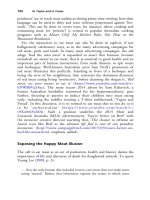The palgrave international handbook of a 244
Bạn đang xem bản rút gọn của tài liệu. Xem và tải ngay bản đầy đủ của tài liệu tại đây (37.08 KB, 1 trang )
International Trade in Animals and Animal Parts
239
unique in enforcing such a ban. Maher and Sollund (2016) suggest this
makes the enforcement of CITES for reptile species in Norway more
effective. The ban is also likely to eliminate many of the harms reptiles
would expect to suffer as part of the legal trade. However, caution is
required as bans are not necessarily effective in all locations and circumstances (see Lemieux and Clarke’s (2009) evaluation of the 1989 CITES
ban on ivory) and may have unexpected and unacceptable consequences
(Rivalan et al. 2007). Bans may inflate the value, and thereby the incentive
to kill, certain species (Low 2003, in Sollund 2011, p. 445) and increase the
domestic trade of these species (Guzman et al. 2007; Lemieux and Clark
2009; Moyle 2003).
Prosecution and Punishment
Effective detection and enforcement deters would-be offenders and benefits
animal victims by reducing harm and removing them from the trade.
However, these efforts are diminished by failures to prosecute or punish
offenders. Sollund and Maher (2015) argue IWT offenders are unlikely to be
deterred as few offences are prosecuted and, if prosecuted, offenders commonly only receive fines and are seldom punished to the law’s full extent.
Notably, UK penalties are significantly lower for killing or injuring wildlife
(AWA 2006—a fine and/or six months custody) than for incorrectly trading
or paying duty on wildlife (CEMA—seven years custody and/or an unlimited fine), raising further concerns about sentencing policy and practice and
emphasising the limited consideration for animal welfare (see also UK
Environmental Audit Committee 2012).
The Unofficial Response
NGOs are central to the official and unofficial response, particularly with
regard to prioritising the interests of the animal victims. In the UK, NGOs
provide financial support to enforcement agencies, scientific and welfare
evidence and advice to government agencies, and facilitate public and political education and awareness (see TRAFFIC, WWF, World Animal
Protection [WAP]). More importantly, perhaps, NGOs have provided prevention and intervention strategies aimed to help animal victims. In doing
so, NGOs prevent the removal of animals from the wild and, where possible,
facilitate their return. Technology has altered the nature of the IWT trade,
removing barriers, facilitating communication and trade between offenders









